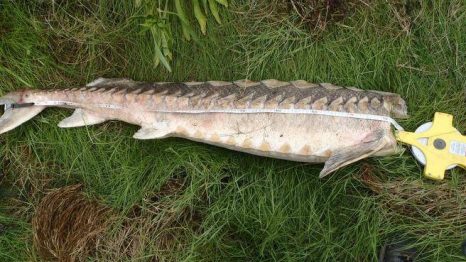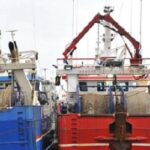Tag Archives: Fundy Ocean Research Center for Energy

New turbines just as lethal as Annapolis turbines
Much more needs to be said and written about the testing of tidal stream turbines in Minas Passage. Graham Daborn, emeritus professor at Acadia University, wrote an Opinions article under this heading (Oct. 15), but without the “more”. Unfortunately much of what has been said and written comes from the proponents of tidal power. And they have obscured the facts about what the physical properties of their machines can do to living organisms. People living around Minas Basin still talk about what happened when the first turbine was installed at the FORCE (Fundy Ocean Research Center for Energy) experimental site in 2009. Two humpback whales suddenly showed up on Minas Basin beaches with large gashes in their bodies. That turbine suddenly stopped working and when it was lifted in 2010 blades were broken. What broke them? Annapolis was installed as a test turbine and 31 years later it is still spinning, still killing fish (five sturgeon and counting this year). There never was an environmental assessment. Read the op-ed here 09:43
Gaspereau River fishermen worried the fish may not make it up the river if turbines are in the water
 Some fishermen along the Gaspereau River are concerned how tidal turbines could affect a local fishery. There are 14 active square net licences in the Gaspereau and Melanson area issued by the Department of Fisheries and Oceans. Those fishermen catch Gaspereau, a species of herring, when they swim up the river from the Bay of Fundy in April and May. On Monday night at the Gaspereau Community Hall, people in the area had their chance to speak to FORCE (Fundy Ocean Research Center for Energy), the organization behind the tidal turbine project. “We want to have some meaningful dialogue with Cape Sharp and FORCE about this project they’re undertaking,” said Chris Gertridge, with the Gaspereau Fishermen’s Association. “We have a lot of questions as to why we’re never consulted.” Read the rest here 14:24
Some fishermen along the Gaspereau River are concerned how tidal turbines could affect a local fishery. There are 14 active square net licences in the Gaspereau and Melanson area issued by the Department of Fisheries and Oceans. Those fishermen catch Gaspereau, a species of herring, when they swim up the river from the Bay of Fundy in April and May. On Monday night at the Gaspereau Community Hall, people in the area had their chance to speak to FORCE (Fundy Ocean Research Center for Energy), the organization behind the tidal turbine project. “We want to have some meaningful dialogue with Cape Sharp and FORCE about this project they’re undertaking,” said Chris Gertridge, with the Gaspereau Fishermen’s Association. “We have a lot of questions as to why we’re never consulted.” Read the rest here 14:24
Meanwhile in the Bay of Fundy, Nova Scotia government approves “experimental” turbine deployment
 The Nova Scotia government has approved a plan to deploy two experimental tidal turbines in the Minas Passage for research purposes. The government announced the approval of the proposed monitoring program for the Fundy Ocean Research Center for Energy (FORCE) and Cape Sharp Tidal Venture in a news release on Monday. The turbines, which are each 16 metres in diameter and weigh 1,000 tonnes, were originally scheduled for deployment last year, but were delayed by weather. Fishermen and environmental groups have raised concerns that the giant turbines would have a negative impact on marine life in the Bay of Fundy. Environment Minister Margaret Miller said in a news release that the full environmental impact of the project will not be known until the turbines are in the water. Read the rest here 11:34
The Nova Scotia government has approved a plan to deploy two experimental tidal turbines in the Minas Passage for research purposes. The government announced the approval of the proposed monitoring program for the Fundy Ocean Research Center for Energy (FORCE) and Cape Sharp Tidal Venture in a news release on Monday. The turbines, which are each 16 metres in diameter and weigh 1,000 tonnes, were originally scheduled for deployment last year, but were delayed by weather. Fishermen and environmental groups have raised concerns that the giant turbines would have a negative impact on marine life in the Bay of Fundy. Environment Minister Margaret Miller said in a news release that the full environmental impact of the project will not be known until the turbines are in the water. Read the rest here 11:34
Fundy Tidal tests on hold, more consultations to be held before turbine launch
 Cape Sharp Tidal has put the brakes on the deployment of its first turbine in the Bay of Fundy, originally set for this weekend so it can meet with concerned community members. Sarah Dawson, community relations manager with Cape Sharp Tidal told the Chronicle Herald Thursday that despite extensive outreach activities, there are still stakeholders in the region that feel like they have not been fully heard. “We are taking a pause to. . .hear from those who don’t feel like they have an opportunity. It’s important that we listen and we learn and we always learn from these sorts of engagements,” Dawson said in an interview. (then they’ll stick it in!) Dawson wouldn’t say how long they will be delaying the deployment. “It’s a positive step,” said Minas Basin weir fisherman Darren Porter. Read the rest here 19:05
Cape Sharp Tidal has put the brakes on the deployment of its first turbine in the Bay of Fundy, originally set for this weekend so it can meet with concerned community members. Sarah Dawson, community relations manager with Cape Sharp Tidal told the Chronicle Herald Thursday that despite extensive outreach activities, there are still stakeholders in the region that feel like they have not been fully heard. “We are taking a pause to. . .hear from those who don’t feel like they have an opportunity. It’s important that we listen and we learn and we always learn from these sorts of engagements,” Dawson said in an interview. (then they’ll stick it in!) Dawson wouldn’t say how long they will be delaying the deployment. “It’s a positive step,” said Minas Basin weir fisherman Darren Porter. Read the rest here 19:05
Bay of Fundy Fishermen want more studies before tidal turbines tested
 The bounties of the Bay of Fundy have sustained us for over 400 years. The Upper Bay of Fundy is an important spawning, nursery and feeding ground for many fish, mammals, and invertebrate species. They include species-at-risk, such as white shark, striped bass, sturgeon and inner Bay of Fundy Atlantic salmon, among others. The is the most important nursery for lobster larvae in Atlantic Canada and fulfills the same function for sea scallops, cod, haddock, gaspereau and many other commercially valuable species that exit the basin through Minas Passage, populating the entire Gulf of Maine. In 2014, $464 million worth of lobster were taken from the Bay of Fundy on Nova Scotia’s side alone. Landings and value were both up significantly in 2015. The three million pounds of allowable scallops fetched about $50 million. In excess of three-quarters of a billion dollars was extracted from Nova Scotia’s waters last year. And it will happen again this year, next year, and every year — truly a renewable resource. Read the Op-ed here 12:22
The bounties of the Bay of Fundy have sustained us for over 400 years. The Upper Bay of Fundy is an important spawning, nursery and feeding ground for many fish, mammals, and invertebrate species. They include species-at-risk, such as white shark, striped bass, sturgeon and inner Bay of Fundy Atlantic salmon, among others. The is the most important nursery for lobster larvae in Atlantic Canada and fulfills the same function for sea scallops, cod, haddock, gaspereau and many other commercially valuable species that exit the basin through Minas Passage, populating the entire Gulf of Maine. In 2014, $464 million worth of lobster were taken from the Bay of Fundy on Nova Scotia’s side alone. Landings and value were both up significantly in 2015. The three million pounds of allowable scallops fetched about $50 million. In excess of three-quarters of a billion dollars was extracted from Nova Scotia’s waters last year. And it will happen again this year, next year, and every year — truly a renewable resource. Read the Op-ed here 12:22













































